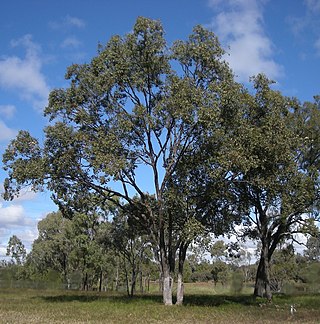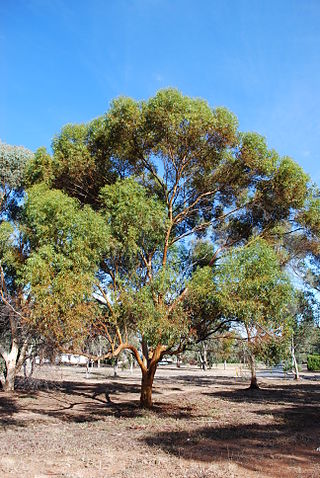
Eucalyptus populnea, commonly known as poplar box, bimble box or bimbil box, is a species of small to medium-sized tree that is endemic to eastern Australia. It has rough, fibrous or flaky bark on the trunk and branches, egg-shaped, elliptical or more or less round leaves, flower buds arranged in groups of seven to fifteen or more, white flowers and conical, hemispherical or cup-shaped fruit.

Eucalyptus salubris, commonly known as gimlet, fluted gum tree, gimlet gum and silver-topped gimlet, is a species of mallet that is endemic to low-rainfall areas of the wheatbelt and goldfields regions of Western Australia.
Eucalyptus conspicua, commonly known as Gippsland swamp-box, is a species of small tree that is endemic to southeastern Australia. It has rough, thick, fibrous bark from the trunk to its small branches, lance-shaped to curved adult leaves, flower buds in groups of seven, white flowers and conical or hemispherical fruit. The crown of the tree is composed of a dull bluish-green juvenile, intermediate and adult leaves.

Eucalyptus intertexta, commonly known as inland red box, western red box, gum coolibah or the bastard coolibah, is a species of tree that is endemic to central Australia. It has rough, fibrous or flaky bark on the base of the trunk, smooth white to brownish bark above, lance-shaped adult leaves, flower buds in groups of seven on the ends of branchlets, white flowers and cup-shaped to hemispherical fruit.

Eucalyptus magnificata, commonly known as blue box or northern blue box, is a species of small tree or sometimes a mallee that is restricted to a small area of New South Wales. It has rough, fibrous or flaky bark on the trunk and larger branches, smooth bark above, broadly lance-shaped to egg-shaped leaves, flower buds in groups of seven, white or pale yellow flowers and conical fruit.

Eucalyptus campaspe, commonly known as silver gimlet or the silver-topped gimlet, is a species of tree that is endemic to Western Australia. It has smooth, shiny bark, lance-shaped adult leaves, flower buds in groups of seven, white flowers and cup-shaped or conical fruit.

Eucalyptus effusa, commonly known as rough-barked gimlet, is a species of mallee or small tree that is endemic to Western Australia. It has thin, rough bark on the base of the trunk, smooth bark above, linear to narrow lance-shaped adult leaves, flower buds arranged in groups of seven, white flowers and cup-shaped to conical fruit.

Eucalyptus fraseri, commonly known as Balladonia gum, is a species of tree or mallet that is endemic to Western Australia. It has smooth white to greyish bark, lance-shaped or curved adult leaves, flower buds in groups of seven or nine, white flowers and cup-shaped, conical or hemispherical fruit.
Eucalyptus jimberlanica, commonly known as Norseman gimlet, is a species of mallet or a tree and is endemic to a small area in the Goldfields-Esperance region of Western Australia. It has smooth, brownish bark, lance-shaped adult leaves, flower buds in groups of seven and conical to cup-shaped fruit.
Eucalyptus limitaris is a species of tree or mallee that is endemic to north-west Australia. It has rough, flaky or fibrous bark on the trunk and branches, lance-shaped to curved adult leaves, flower buds in groups of seven on a branching peduncle and conical to barrel-shaped or cup-shaped fruit.
Eucalyptus optima, is a species of small to medium-sized tree or a mallet that is endemic to a small area in the south of Western Australia. It has smooth white to greyish bark, sometimes with rough black bark on the base of the trunk, lance-shaped adult leaves, flower buds in groups of seven or nine, pale yellow flowers and cup-shaped, hemispherical or urn-shaped fruit.
Eucalyptus tortilis is a species of mallet and a gimlet that is endemic to the southwest of Western Australia. It has smooth bark, lance-shaped adult leaves, flower buds in groups of seven, creamy white flowers and hemispherical to cup-shaped fruit.
Eucalyptus creta, commonly known as the large-fruited gimlet, is a species of mallet or tree that is endemic to Western Australia. It has smooth, shiny bark, lance-shaped adult leaves, flower buds in groups of three in leaf axils, relatively large white to creamy yellow flowers, and broadly hemispherical to bell-shaped fruit.

Eucalyptus diptera, commonly known as the two-winged gimlet, is a mallet that is endemic to the south-west of Western Australia. It has smooth greenish to brownish bark, linear to lance-shaped adult leaves, flower buds in groups of three, each with two wings along the sides, creamy white to pale lemon-coloured flowers and cup-shaped to hemispherical fruit, also with two wings on the sides.
Eucalyptus educta is a spreading, twisted mallee that is endemic to Western Australia. It has reddish brown minni ritchi bark, more or less rounded to egg-shaped leaves, glaucous flower buds arranged in groups of seven, creamy white flowers and flattened hemispherical fruit.

Eucalyptus extensa is a species of mallet that is endemic to Western Australia. It has smooth bark, lance-shaped adult leaves, flower buds in groups of seven, yellowish green flowers and hemispherical fruit with the valves extended well beyond the level of the rim.
Eucalyptus tephrodes is a species of small tree or mallee that is endemic to Western Australia. It has rough bark on the trunk and larger branches, smooth bark above, egg-shaped to lance-shaped adult leaves, flower buds in groups of three on the ends of branchlets and cup-shaped to hemispherical fruit.

Eucalyptus terebra, commonly known as Balladonia gimlet, is a species of gimlet that is endemic to Western Australia. It has satiny or glossy bark on its fluted trunk, linear to narrow lance-shaped adult leaves, flower buds in groups of seven, yellowish flowers and conical to hemispherical fruit. It is one of the seven species of gimlet.
Eucalyptus lockyeri, commonly known as Lockyer's box, is a species of small tree endemic to a small area in Queensland. It has rough bark near the base of the trunk, smooth bark above, lance-shaped adult leaves, flower buds in groups of seven, white flowers and hemispherical fruit.
Eucalyptus farinosa is a species of small tree that is endemic to Queensland. It has hard, dark grey ironbark, egg-shaped to lance-shaped adult leaves, flower buds in groups of seven, white flowers and cup-shaped to barrel-shaped and ribbed fruit.









